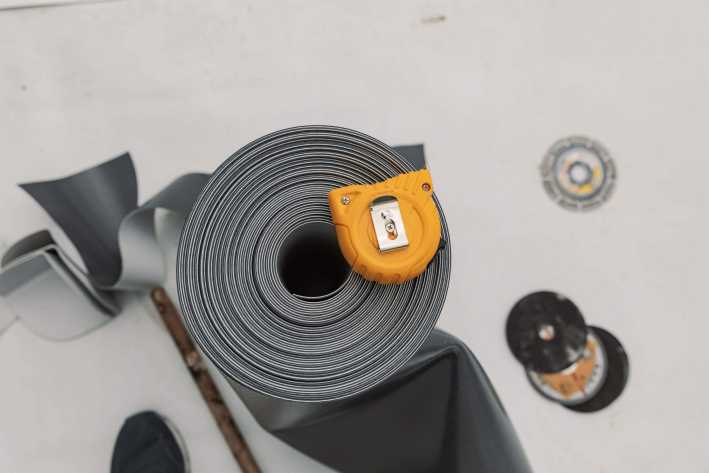
Architectural shingle roof: From A to Z
When you face the need to select between a few roofing materials, you consider factors like cost,...
If you're on the hunt for durable roofing that requires little maintenance, rubber shingles might be your answer. This material suits well for flat roofs and is commonly seen on commercial and industrial buildings. Besides, rubber roofing is used as a protective layer over the existing roof as it is robust enough to withstand harsh weather conditions. Like its concrete and composite counterparts, rubber can mimic slate or cedar shake while having a much lower price. Keep reading to learn about the types of rubber roof shingles, their distinctive features, and maintenance requirements. We will update you on up-to-date prices on this roofing material and its installation.

Rubber roofs are made of a combination of plastic polymers and recycled rubber. This material is considered eco-friendly and sustainable as it has sawdust, used tires, and slate dust in its composition. Rubber roofing provides ultimate energy efficiency and is used for better roof sealing. This material commonly substitutes asphalt shingles as it has better waterproofing features and flexible nature.
Rubber tiles of thick grade possess rich texturing and excellent durability. Depending on the selected rubber roof type, you can expect its service life to be 30-50 years. However, it may last even longer if installed with proper drainage in mind.
If you worry about maintenance spending on a rubber roof, then don't. Shingles made of this material don't require much upkeep compared to most types of roofing systems. Small damage repair can be performed without professional assistance. All you need is a special adhesive or rubber liquid sealant. However, as with any other roofing material, you should not skip routine check-ups and cleans. It will help maintain the roof's surface in good condition and enhance its resistance to cracking.

Not all rubber roofs are created equally. Three main types are distinguished, including EPDM, TPO, and PVC. These rubber roofing variabilities are used for low-slope roofs, while rubber shingles are for pitch ones or as the second layer for metal roofs. Each of these roofing types comes with distinct features worth mentioning.
Ethylene propylene diene terpolymer is a synthetic rubber roofing material used for flat roofs. EPDM comes in seamless sheets and can be easily installed on the roof. This is one of the most cost-effective materials as it offers a long lifespan (30-50 years) while costing from $1 to $4 per square foot. EPDM roofing is thick and robust enough to withstand hail and high winds. However, due to a specific way of installation, it has weak seams that can allow moisture to be trapped inside the house. Another drawback of EPDM is its black color. If you live in a sunny state, your roof will attract and accumulate heat.
Thermoplastic polyolefin is a relatively new single-ply roofing material that has similar properties to EPDM but varies in several key ways. First off, this is a more affordable and energy-efficient roofing option that has better water resistance. It differs from EPDM in the installation approach, where seams are welded by a hot air gun rather than sealed with adhesive or tape. Secondly, thermoplastic polyolefin comes in different colors, including gray and white, making it a suitable option for hot climates. However, you should consider that TPO roofing installation requires more skill and time than EPDM. It might be troublesome to find an expert who has proven experience working with this type of rubber roofing. You should expect to pay around $3.5 per square foot of TPO roof.
Polyvinyl chloride is another type of rubber roofing made of plasticizers and chlorine salts. It possesses similar properties as TPO in terms of waterproofing and heat resistance. However, polyvinyl chloride roofing is even more flexible and resilient thanks to the plasticizers in its composition. These features make PVC resistant to building-settling. Besides, polyvinyl chloride is best to withstand hail storms, heavy rains, and winds. PVC installation involves welding seams with a hot air gun similar to TPO, which explains its longevity (up to 30 years) and moisture resistance. The downside of PVC rubber roofing lies in its toxicity. This material contains the chemical chlorine that emits dioxins during its lifecycle. The cost of PVC roofing might also be a deal breaker for some homeowners. It ranges from $4 to 7$ per square foot.
Many people believe that installing a new roofing material on a flat roof is simpler and less expensive than pitched ones. It's only partially true as working on flat surfaces is more labor intensive than on the steep ones. Of course, flat roofs are much easier to access, and no ladders or brace system is required. Nevertheless, the process involves more stooping and lifting as well as the application of complicated application techniques. That is why rubber roof installation may have the same or higher price than a pitched roof.
Rubber materials are typically more expensive than many other widely used roofing options. For instance, the cost of asphalt shingles ranges between $1.20 - $3.50 per square foot, while rubber ones from $4.25 to $8.25. However, you will get more advantages for this price than asphalt shingles, or asphalt roll roofing can offer.
Read more in article - Rubber roof cost.
Leverage our handy contractor-matching platform to get a clear-cut cost estimate for your rubber roofing project. By matching thousands of roofers' offers from all over the country, we can give you a precise quote based on your location, roof's square footage, and the selected material.
GET THE ESSENCE OF RELEVANT HOME
IMPROVEMENT TOPICS IN LESS THAN 5 MINUTES

When you face the need to select between a few roofing materials, you consider factors like cost,...

Shingles fall under the most sought-after roofing type for residential property. They perfectly m...

Stay tuned!